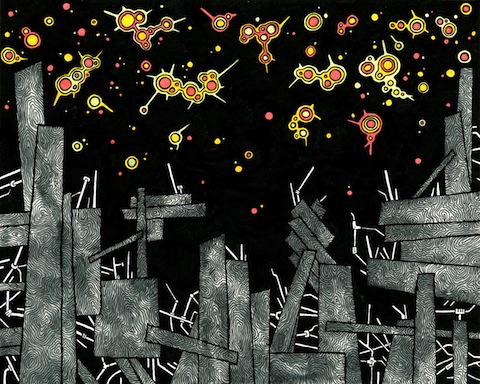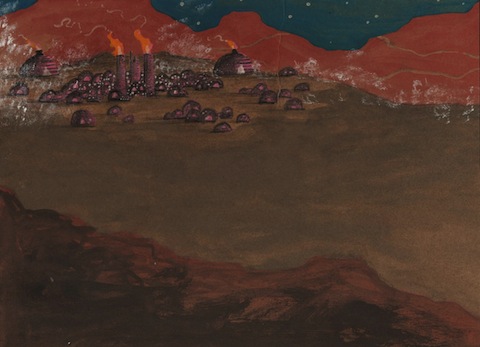
The medieval travelogue presents present-day writers and artists with an abundance of material. Writing in an age when the boundaries between fiction and non- were not so sharply drawn, early explorers and sailors had little compunction about embellishing their tales with exaggerations and outright lies. Travelers circulated stories of giants and monsters and credulous readers back home swallowed them whole. Well, sometimes. In the case of the most famed medieval traveler, Marco Polo, scholars have debated whether Il Milione—one of the titles of a narrative based on his accounts—refers to a family nickname or to Polo’s reputation for telling “a million lies.” But whether Polo told the truth or not hardly mattered to Italo Calvino, who found in the explorer’s colorful tales just the inspiration he needed for his 1972 novel Invisible Cities.

More a series of vignettes than a narrative, the book consists of chapter after chapter of Polo describing for Kublai Khan the various cities he encountered on his travels, each one more fantastic and magical than the last. “Kublai Khan does not necessarily believe everything Marco Polo says,” Calvino tells us in his introduction, “but the emperor of the Tartars does continue listening to the young Venetian with greater attention and curiosity than he shows any other messenger or explorer of his.” As readers, we too listen with rapt attention to curious stories of cities like Olinda, which “grows in concentric circles, like tree trunks which each year add one more ring” and Eusapia, where “the inhabitants have constructed an identical copy of their city, underground,” so that the dead can “continue their former activities.”

Playing on the bizarre nature of travelers’ tales and the imaginative excesses of exotic romances, Calvino’s novel abounds in delightful architectural absurdities and puzzling allegories, almost demanding to be illuminated like a medieval manuscript. Deciding to meet the challenge, artists Matt Kish, Leighton Connor, Joe Kuth began illustrating Invisible Cities in April of 2014. Their tumblr, Seeing Calvino, updates every Wednesday with a new interpretation of the novel’s many strange cities. At the top of the post, see “Thekla,” the “city forever under construction,” by Kish. Below it, Kuth’s imagining of “Irene,” the “name for a city in the distance, and if you approach it, it changes.” And just above, Connor’s interpretation of “Beersheba,” in which it is believed that “suspended in the heavens, there exists another Beersheba … They also believe, these inhabitants, that another Beersheba exists underground.”

Seeing Calvino isn’t Kish’s first foray into literary illustration. Previously, he undertook an illustration of every page of Melville’s Moby Dick, an impressive effort we featured last week. (Above, see another of his Invisible Cities pieces, “Adelma.”) Of the new, collaborative Calvino project, Kish tells us, “the episodic structure really appealed to us and we thought it was the perfect kind of thing to build a tumblr around and share with people.”
Invisible Cities has been fascinating to create… each of us brings a very different approach to the work. Joe’s Cities tend to be far more literal, realistic and representational, which I find kind of staggering because that is so difficult to do with Calvino. My illustrations are far more abstract and conceptual, trying to show in symbolic ways the ideas behind each chapter. Leighton falls somewhere between us on that spectrum, and his work has elements of realism and abstraction. None of us even talked about this before we started, we simply began independently (after settling on a rotation) and watched each other’s work evolve.
The three artists of Seeing Calvino have to date painted 45 of the 56 cities in Calvino’s novel. Kish has also illustrated Joseph Conrad’s Heart of Darkness, and his blog features many other graphic interpretations of literary and cinematic works. The Moby Dick project saw publication as a book in 2011. We can only hope that Calvino’s publisher sees the value of an Invisible Cities edition incorporating Kish, Kuth, and Connor’s illustrations.
You can visit Seeing Calvino here.
Related Content:
An Illustration of Every Page of Herman Melville’s Moby Dick
Watch a Whimsical Animation of Italo Calvino’s Short Story “The Distance of the Moon”
Italo Calvino Offers 14 Reasons We Should Read the Classics
Josh Jones is a writer and musician based in Durham, NC. Follow him at @jdmagness


Leave a Reply